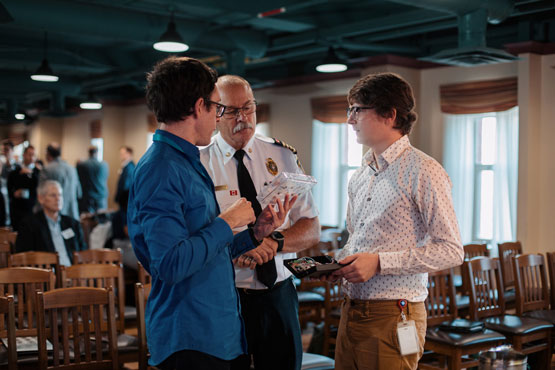December 4, 2023
The Canadian Safety and Security Program hosted an Innovation Day in Ottawa on Nov. 16, 2023, focused on science and technology to bridge capability gaps for the first responder and preparedness and resilience communities. The event connected researchers from across government departments and industry with people with the first-hand, on-the-ground knowledge of needs, including federal, provincial, territorial, and municipal governments, Indigenous organizations, as well as industry and academic representatives.

Representatives from government and industry partners provided updates on Canadian Safety and Security Program funded projects at Innovation Day in Ottawa on Nov. 16, 2023. Left to right: Nadia Rochdi, technical director EI products at Northstar Earth & Space; Enda Murphy, senior research engineer at the National Research Council of Canada; and Michael Henschel, director of operations at C-CORE.
Topics covered a wide range of projects funded by the Canadian Safety and Security Program, including front-line technology supports for first responders and tools to develop resilience to climate change.
First responder technology
Ryan Griffin, project leader of a research team at the National Research Council of Canada (NRC), presented their work to develop printable and wearable sensors with wireless readout for first responders such as firefighters. Currently, most hazardous materials, or HazMat, teams in Canada need to carry bulky sensors to detect chemical, biological, radiological and nuclear materials. This research project is developing hands-free chemical sensors to gather the information that first responders need for proper decontamination after an event.

At Innovation Day in Ottawa on Nov. 16, 2023, researchers connected with first responders on science and technology that is being developed with support from the Canadian Safety and Security Program. Left to right: Ryan Griffin, a project leader at the National Research Council of Canada (NRC), David Matschke, Deputy Chief of Ottawa Fire Services, and James Neumann, also a researcher with the NRC, discuss printable and wearable chemical sensors to detect hazardous materials for enhanced situational awareness.

At Innovation Day in Ottawa on Nov. 16, 2023, National Research Council of Canada (NRC) researchers showcased printable chemical sensors to detect hazardous materials for first responders, which are being developed with Canadian Safety and Security Program funding support.
A researcher with Public Safety Canada, provided an update on a research project to improve stress training for first responders. By combining real-time physiological data such as heart rate and breathing, with a device to measure cognitive effort called near-infrared spectroscopy (NIRS), researchers are working to hit the “sweet spot” of training that mimics stress levels of emergency situations. This data could help first responders “train like you fight,” where training is neither so easy that it does not prepare for actual stress levels, nor so difficult that people are overwhelmed. Eventually, this research could be applied to identify individuals who can perform in high-stress, high cognitive-load situations during candidate assessment, with the ultimate goal of preventing post-traumatic stress disorder.
Climate resilience
Coastal regions are vulnerable to the effects, but NRC researcher Enda Murphy provided an update on research on nature-based infrastructure solutions, including sediment-based, vegetation-based, and hybrid options. For example, he spoke about a project to build a “living dyke” of salt marshes to increase resiliency to storms and coastal flooding. The research project has fed into design guidance, developed with national, regional and local experts, expected to be published soon.
Nadia Rochdi, of Northstar Earth and Space, updated on an earth observation project to monitor marine pollution such as oil spills, ice conditions, and coastal ecosystems. This project combines data from multiple sources including multispectral imaging and synthetic aperture radar on the Sentinel-1 and Sentinel-2 satellites, with hyperspectral imaging from airborne platforms. Prototype testing is planned in 2024.
Another researcher from Defence Research and Development Canada’s Centre for Security Science provided an update on a trial on wildfire sensors, conducted with the US Department of Homeland Security this summer. Wildfire sensors can detect volatile organic compounds in the air and send alerts in real-time to give responders advance warning to control wildfires. Researchers are working to gather data on optimal locations to install these sensors to best protect communities.

Researchers provided an update on wildfire sensor research at Innovation Day in Ottawa on Nov. 16, 2023. Researchers are working to determine optimal locations for sensors to provide earlier warning to responders and protect communities from wildfires.
Additional updates touched on projects as wide-ranging as improving ice edge monitoring in the Arctic, to advances in wireless communications for public safety.
The Innovation Day was a first for the Canadian Safety and Security Program as part of ongoing engagements with stakeholders in the safety and security communities.
